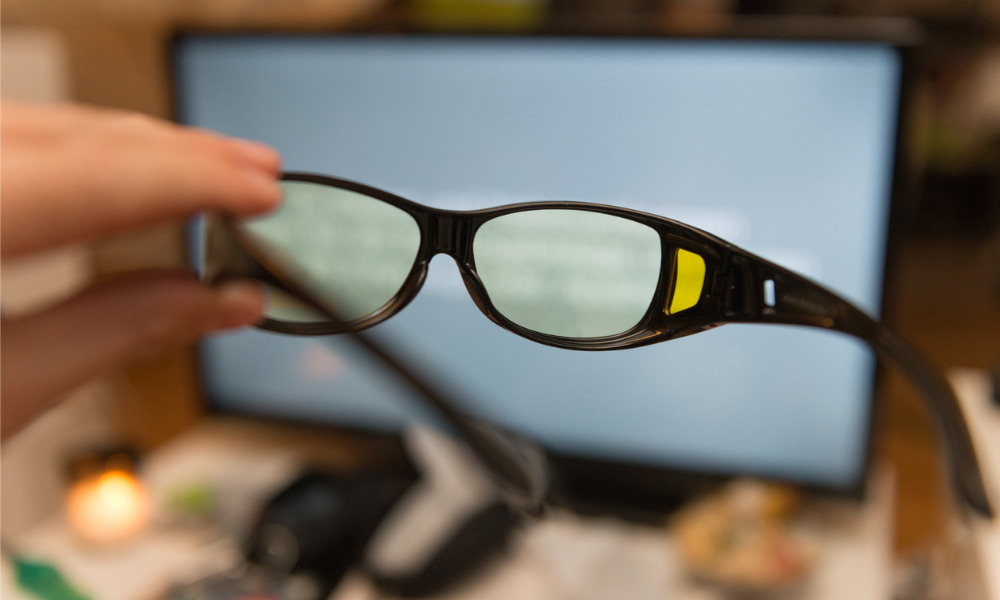What are blue light glasses, and do they even work?

This pandemic has seen many of us staring at our screens more so than ever before: work laptops, televisions, phones, etc. For those working from home, it can feel as if life is just one never-ending screen.
This is a huge issue as it can eventually cause vision problems, eye strain, dry eyes and headaches or migraines.
Protecting your eyes is essential, and there are a number of ways to do so, from plain old eye drops to blue light glasses. In the workplace, wearing the right kind of PPE and being aware of hazards plays a huge part to keeping your eyes safe.
Blue light-blocking glasses have been around for a minute, and are frequently offered by many opticians as a solution for digital eye strain. But are they just another gimmick or are they actually effective?
But first, what even is blue light?
In an article on their website, Texas-based eye care office Vision Corner explains that blue light is essentially everywhere: it is found in the sun, but also in fluorescent lighting and the screens of electronic devices. Compared to other types of light, blue light emits shorter wavelengths and more energy.
Now, with more and more people glued to their screens, eye health professionals are worried about excessive exposure to blue light.
What are blue light glasses?
A 2020 article on Medical News Today by Jessica Caporuscio explains that blue light glasses are lenses that manufacturers claim can filter out the blue light being emitted from screens et al. These glasses have a surface coating on the lenses, or are made from filtering materials, that block out a certain portion of blue light.
Caporuscio explains that “blue light itself is a short-wave blue light in the spectrum of colors visible to the human eye. Its wavelength is in the blue portion of the electromagnetic spectrum, which is roughly 400–500 nanometers (nm). Researchers believe that peak light damage occurs roughly at 440 (nm).”
What’s the difference between computer glasses and blue light glasses?
In a video, Dr. Allen of YouTube channel Doctor Eye Health says that “computer glasses are a dedicated pair of glasses with a magnification power to relieve eye strain while looking at a near object that is about the distance of your computer screen.” In essence, they are very similar to reading glasses in that they help the user see the screen (or read) better while not being to close (which strains the eyes).
The difference resides in the treatment of the lenses, the aim of computer glasses is to magnify near objects while blue light glasses are treated to bounce blue light away.
Do blue light glasses really work?
In an interview with NPR, Dr. Mark Rosenfield, professor at the College of Optometry at State University of New York, said that blue light-blocking glasses aren’t actually a solution for digital eye strain.
His findings are based on a study he conducted which essentially found that blue-blocking filters produced no big change in the symptoms of digital eye strain.
This is a sentiment echoed by the College of Optometrists, who say that at this point in time:
“The best scientific evidence currently available does not support the use of blue-blocking spectacle lenses in the general population to improve visual performance, alleviate the symptoms of eye fatigue or visual discomfort, improve sleep quality or conserve macula health.”
Can blue light glasses cause headaches?
It doesn’t seem to be the case – in fact, many blue light-blocking lense manufacturers claim that they can actually help ease or prevent headaches.
What are blue light glasses good for?
Rosenfield says that blue light emitted from tech devices such as computers or phones can interfere with our bodies’ light cycle (our sleep pattern, essentially). Using blue light-blocking glasses can apparently help to temper the effects of blue light on the body’s natural rhythm.
Caporuscio’s article mentions a 2019 study which suggests that these kinds of glasses may be beneficial for treating sleep disorders in people suffering from Parkinson’s disease.
How to ease eye strain?
Rosenfield mentions the 20-20-20 rule as a way to ease eye strain. In a COS article last year, Lisa Schuiteboer-Shuler, Kensington’s certified Ergonomic Expert and Ergonomic Category Manager, explained the “20/20/20 golden rule”: every 20 minutes, look away from the screen for 20 seconds, and focus your eyes on something at least 20 feet away. Not only does this help with eye sight, it also helps with posture – so killing two birds with one stone!
In an article for the American Academy of Ophthalmology, Celia Vimont writes on top of the 20-20-20 rule, you should sit around 25 inches away from the computer screen, and position it so that you are gazing slightly downwards.
Furthermore, you can also use artificial tears to refresh your eyes if they feel dry.





